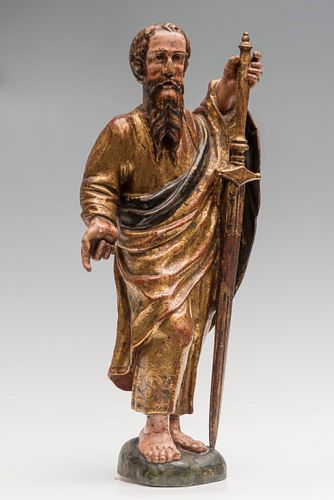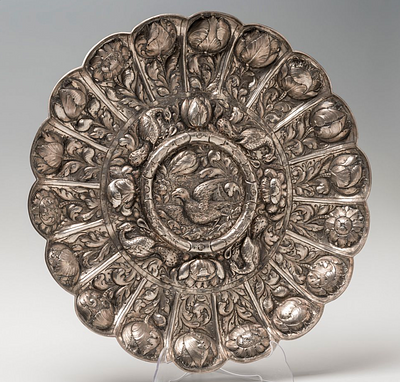Castilian school; XVI century. "Saint Paul".
Lot 33
About Seller
Setdart Auction House
Carrer Aragó 346
Barcelona
Spain
Setdart Subastas was born in 2004 and is currently the first online art auction in Spain with solidity, prestige and reliability guaranteed by our more than 60,000 users. Setdart has a young, dynamic and enterprising team ready to successfully manage the purchase and sale of art works through custom...Read more
Categories
Estimate:
EUR€1,500 - EUR€2,000
$1,612.90 - $2,150.54
Absentee vs Live bid
Two ways to bid:
- Leave a max absentee bid and the platform will bid on your behalf up to your maximum bid during the live auction.
- Bid live during the auction and your bids will be submitted real-time to the auctioneer.
Bid Increments
| Price | Bid Increment |
|---|---|
| EUR€0 | EUR€10 |
| EUR€200 | EUR€25 |
| EUR€500 | EUR€50 |
| EUR€1,000 | EUR€100 |
| EUR€3,000 | EUR€200 |
| EUR€5,000 | EUR€500 |
| EUR€10,000 | EUR€1,000 |
| EUR€20,000 | EUR€2,000 |
| EUR€50,000 | EUR€5,000 |
About Auction
By Setdart Auction House
Jul 13, 2021
Set Reminder
2021-07-13 07:00:00
2021-07-13 07:00:00
America/New_York
Bidsquare
Bidsquare : DECORATIVE ARTS XV-XIX
https://www.bidsquare.com/auctions/setdart-auction-house/decorative-arts-xv-xix-7201
Setdart Auction House sofia@setdart.com
Setdart Auction House sofia@setdart.com
- Lot Description
Castilian school; XVI century. "Saint Paul". Carved wood, polychrome and stewed. It presents jumps in the polychrome, gilded at the base, and flaws in the carving. Xylophagous remains. Measures: 40 x 18 x 10 cm. Saint Paul was a Hellenized Jew of the Diaspora, born in Tarsus. He was therefore Jewish by his ethnic origin, Greek by his culture and Roman by his nationality. He received the name Saul, which he changed to Paul after his conversion. Born at the beginning of the first century, he studied in Jerusalem with Rabbi Gamaliel, who was known for his hatred of Christians. One day, when around the year 35 he was on his way from Jerusalem to Damascus, he was dazzled by lightning and fell from his horse. Then he heard the voice of Jesus saying to him: "Saul, Saul, why are you persecuting me? As a result of this experience, the saint went abruptly from persecutor to zealot of Christianity. After curing the blindness of a Christian from Damascus, he began his life as a missionary, until he arrived in Jerusalem where he came into contact with Peter and the other apostles. In the Middle Ages, numerous corporations were placed under his patronage, due to different aspects of his iconography, life and miracles. However, St. Paul was never a popular saint, as evidenced by the relative poverty of his iconography. Spain is, at the beginning of the 16th century, the European nation best prepared to receive the new humanist concepts of life and art because of its spiritual, political and economic conditions, although from the point of view of plastic forms, its adaptation of those introduced by Italy was slower due to the need to learn the new techniques and to change the taste of the clientele. Sculpture reflects perhaps better than other artistic fields this eagerness to return to the classical Greco-Roman world that exalts in its nudes the individuality of man, creating a new style whose vitality surpasses the mere copy. Soon the anatomy, the movement of the figures, the compositions with a sense of perspective and balance, the naturalistic play of the folds, the classical attitudes of the figures began to be valued; but the strong Gothic tradition maintains the expressiveness as a vehicle of the deep spiritualistic sense that informs our best Renaissance sculptures. This strong and healthy tradition favors the continuity of religious sculpture in polychrome wood that accepts the formal beauty offered by Italian Renaissance art with a sense of balance that avoids its predominance over the immaterial content that animates the forms. In the first years of the century, Italian works arrived in our lands and some of our sculptors went to Italy, where they learned first hand the new norms in the most progressive centers of Italian art, whether in Florence or Rome, and even in Naples. Upon their return, the best of them, such as Berruguete, Diego de Siloe and Ordóñez, revolutionized Spanish sculpture through Castilian sculpture, even advancing the new mannerist, intellectualized and abstract derivation of the Italian Cinquecento, almost at the same time as it was produced in Italy.
- Shipping Info
-
In-house shipping available. Please inquire at admin@setdart.com.
-
- Buyer's Premium



 EUR
EUR CAD
CAD AUD
AUD GBP
GBP MXN
MXN HKD
HKD CNY
CNY MYR
MYR SEK
SEK SGD
SGD CHF
CHF THB
THB

















